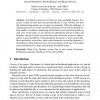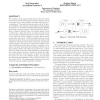13 search results - page 2 / 3 » Proof that pyramid networks are 1-Hamiltonian-connected with... |
PODC
2010
ACM
13 years 9 months ago
2010
ACM
The study of complex networks led to the belief that the connectivity of network nodes generally follows a Power-law distribution. In this work, we show that modeling large-scale ...
CORR
2008
Springer
13 years 7 months ago
2008
Springer
Distributed systems are now both very large and highly dynamic. Peer to peer overlay networks have been proved efficient to cope with this new deal that traditional approaches can ...
SAGA
2007
Springer
14 years 1 months ago
2007
Springer
In the layered-graph query model of network discovery, a query at a node v of an undirected graph G discovers all edges and non-edges whose endpoints have different distance from ...
SIGECOM
2006
ACM
14 years 1 months ago
2006
ACM
Braess’s Paradox is the counterintuitive but well-known fact that removing edges from a network with “selfish routing” can decrease the latency incurred by traffic in an eq...
PE
2010
Springer
13 years 5 months ago
2010
Springer
We consider a push pull queueing system with two servers and two types of jobs which are processed by the two servers in opposite order, with stochastic generally distributed proc...


